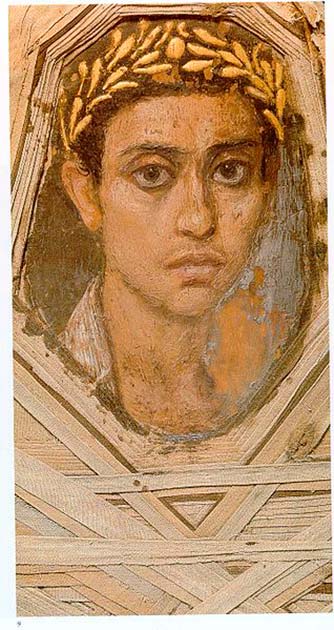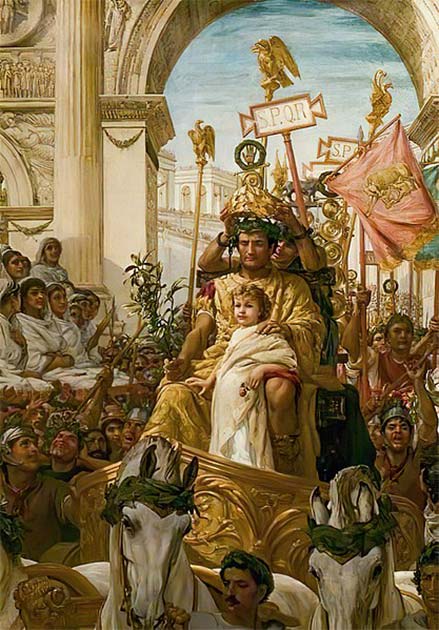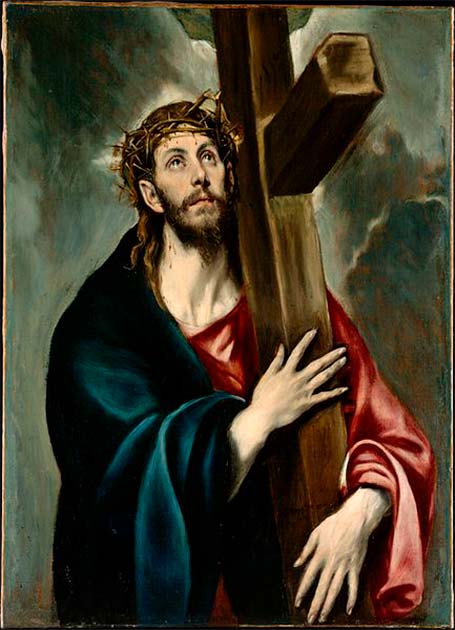Works of Christian Art are filled with symbols that tell the story of the scripture through images. Some common signs include the crucifix/the cross and an ichthys (IXΘΣ which is short for “Ἰησοῦς Χριστὸς Θεοῦ Υἱὸς Σωτήρ” which means Jesus Christ, Son of God, Saviour).
In Roman art, you can find the letters A (alpha) and ω or Ω (omega), which comes from Revelations 22:13, 1:8, and 21:6 and the statement by Christ that “I am Alpha and Omega, the First and the Last, the Beginning and the End.” Besides Greek letters, animals like a lamb (innocence), dove (peace), pelican (self-sacrifice), and peacock (fabulous) are featured in Christian iconograph as biblical scholars and artists cast about for new ways to portray the ineffable.
One of the most easily recognizable symbols in Christian art is the halo. This golden ring of light behind an individual’s head is far more than an accessory or the artist’s attempt to emphasize the “important” figures. The halo, or a glowing aura, is used to illustrate the Crown of Immortality and martyrdom.
So, what is the significance of the Crown of Immortality?
Crown of Immortality
The Crown of Immortality is a common religious and literary metaphor that has evolved from a laurel wreath to a halo, a circle of stars, or an aureola. The Crown of Immortality can be found in Christian Art to indicate that the person wearing the crown is immortal.
While the Crown of Immorality is often associated with Christian iconography, wearing a wreath or crown dates back to ancient Egypt. When someone died, a wreath crown was placed on their head to represent the wearer’s triumph over death in the afterlife. In ancient Egypt, this wreath was called “the crown of justification” and has been described as emulating the god of resurrection, Osiris.

The crown of justification from ancient Egypt was often made of varying materials, such as papyrus, laurel branches, palm fronds, roses, feathers, or precious metals like gold. Depictions of these early Crowns of Immortality can be found in the Fayum mummy portraits from the Roman Imperial period, specifically in Roman Egypt.
- The Spear of Longinus: What happened to the Holy Lance?
- Swoon or Substitute? Two Rationalizations of the Resurrection of Jesus
Wearing wreaths of laurel or olive is often associated with ancient Greece and its presentation to athletes and poets as a signal of victory or knowledge. In Rome, generals who won a battle would often ride through the streets of Rome with a laurel wreath upon their heads.
At that time, wearing a crown of any kind, especially those made from laurel, was something only the Imperial family had the right to do, so if someone else was wearing one, they were important and deserved respect. Like the Roman Imperial purple, it denoted rank.
Placing a Crown of Immortality or a wreath on someone’s head was known as “crowning,” and it was believed that the crown would “secure the wearer’s immorality in the form of enduring flame, but the triumphator (victorious general) would receive a wreath to remind them of their mortality. It was known that a slave would whisper into a general’s ear during processions through the city “memento mori.” The phrase means “remember death” and was another remember that the person, even surrounded by their triumph, was mortal.
Marking of a Martyr
In Christian works of art, you will often see a glowing halo, a wreath, or an aura around the head of a martyr. In the manuscript Martyrdom of Polycarp, the martyrdom of Polycarp, the Bishop of Smyrna, and disciple of Saint John (also known as John the Apostle or Saint John the Beloved) from the fourth century AD is so depicted.
Polycarp was stabbed to death after an attempt to burn him at the stake failed. Polycarp was said to “have been crowned with the wreath of immortality… through patience overcome the unjust governor, and thus acquired the crown of immortality”.
The Martyrdom of Polycarp is an early literary example of being awarded the title of martyr after suffering, death, and persecution. Jesus endured suffering at the hands of the Romans and non-believers when he was crucified, and so did those who have been made martyrs in the eyes of the church.

This is an example of undying faith and refusal to give up their beliefs, even if it meant they signed their own order of execution. The Crown of Immortality also pays homage to the crown of thorns that Jesus was made to wear during the days leading up to his crucifixion. Almost all artistic depictions of saints feature a Crown of Immortality.
Artists would commonly include certain symbols in their work to symbolize martyrs and their victory of good over evil by choosing to give up their lives for God. In medieval artwork, images of a winged figure (Victory), attendants carrying crowns, and palm trees.
- Great Relic of the Israelites: Where is the Ark of the Covenant?
- (In Pics) Six Paintings from History with a Hidden Secret
Palm trees have been used to symbolize martyrdom in works of art because it was once believed that the palm plants “would die while generating fruits, thus being a strong symbol of sacrifice.” Today the church uses palm fronds on Palm Sunday, the Sunday that falls right before Easter.
Works of Art with Crowns of Immortality
In the masterpiece Allegory of Divine Providence and Barberini Power by Pietro de Cortona, the central figure in yellow is Divine Providence. Above her, there are putto (cherubs or cupids), levitating maidens who hold a crown of stars (Crown of Immortality), keys to the church, and other figures in the background have crowns of what appear to be laurels.
In El Greco’s painting Christ Carrying the Cross, Jesus wears the crown of thorns, and a glowing light is behind his head. The light serves as a Crown of Immortality, resurrection, and divinity.

Another fantastic depiction of a Crown of Immortality is the painting Madonna in Glory by Carlo Dolci. Mary Magdalen looks towards the heavens with a crown of stars above her head.
There is also symbolism in Mary’s hands in this painting. Her open palm depicts one whose thoughts are pure, who is a person of faith and truth, and someone with a genuine soul. Her other hand, which rests upon her heart, is a symbol of righteousness and someone who has prayed throughout her life.
Top Image: Eterna (eternity) carries the Crown of Immortality in this depiction in the Swedish House of Nobility. Source: Xauxa / CC BY-SA 3.0.